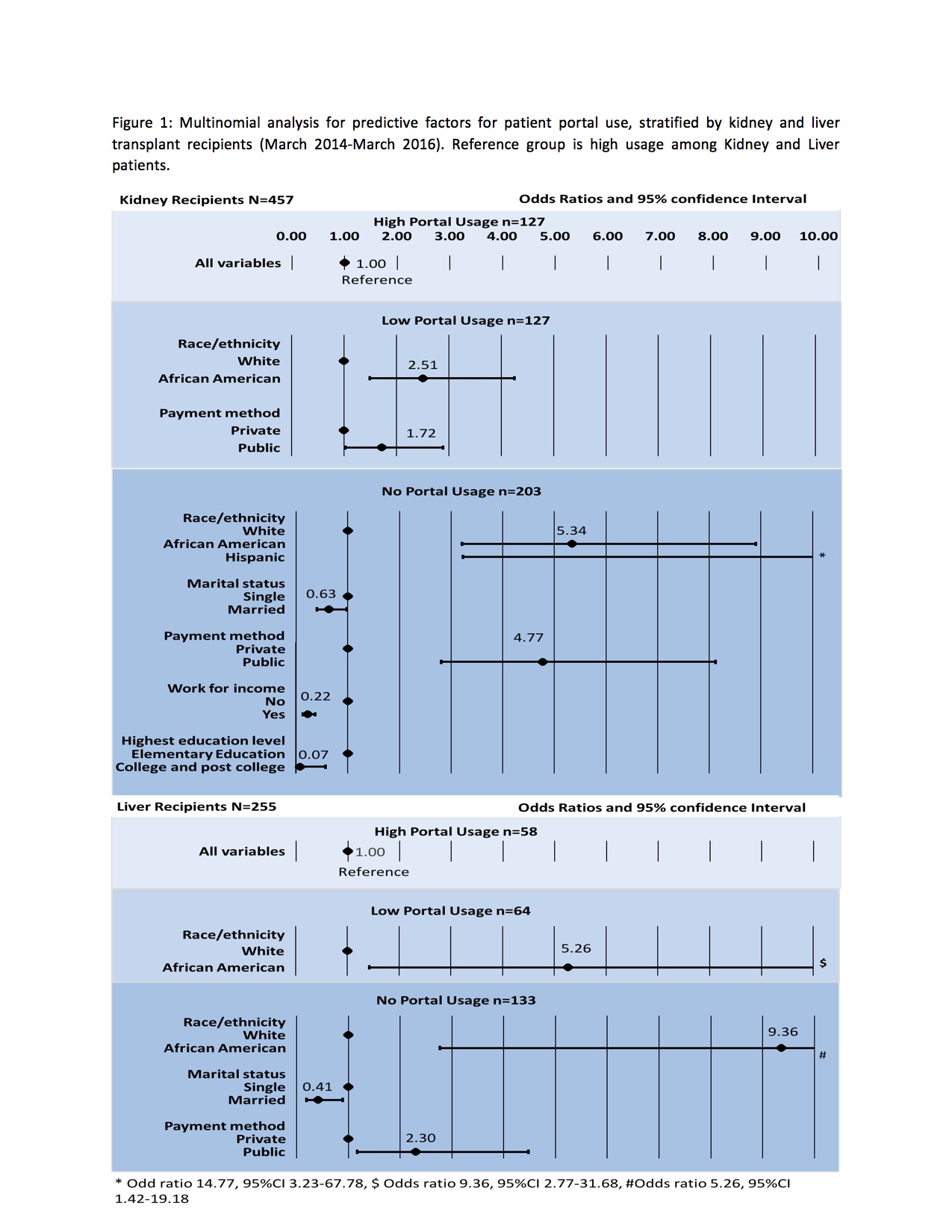Predictors of Web-Based Patient Portal Usage Among Kidney and Liver Transplant Recipients.
A. Ruiz, K. Smith, J. Wedd, K. Little, S. Pastan, R. Patzer.
Surgery, Emory University, Atlanta, GA
Meeting: 2017 American Transplant Congress
Abstract number: 94
Keywords: Kidney, Liver, Psychosocial, Resource utilization
Session Information
Session Name: Concurrent Session: Psychosocial and Mediation Adherence Concerns
Session Type: Concurrent Session
Date: Sunday, April 30, 2017
Session Time: 2:30pm-4:00pm
 Presentation Time: 3:30pm-3:42pm
Presentation Time: 3:30pm-3:42pm
Location: E271b
Background
Little is known about the characteristics of patients who use web-based patient portals for healthcare purposes. The aim of this study was to examine patient characteristics and identify disparities associated with kidney transplant (KTx) and liver transplant (LTx) recipients' portal usage.
Methods
The study population included all KTx and LTx recipients at a large transplant center from March 2014-March 2016. Portal action timestamps (e.g. clicks, messages, etc.) per patient 6 months before until 2 years following transplant were assessed. High or low usage was defined as being above or below the median (3 web clicks per week for KTx and 2 web clicks per week for LTx), or failing to accept a portal invitation. Multinomial logistic regression was used to determine demographic and sociodemographic predictors of portal usage, stratified by organ.
Results
Among 712 transplant recipients, 457 received a KTx and 255 received a LTx. KTx recipients with no and low usage were compared to those with high usage. Among this population, African Americans were 2.5 and 5 times more likely to have low portal usage and no usage, respectively (OR 2.51 CI 1.49-4.25 and OR 5.34 CI 3.21-8.90). Hispanic patients were 14 times less likely to ever use the patient portal compare to whites (OR 14.77 CI 3.23-67.78). Publicly insured patients were ~ 2 and 5 times more likely to have a low and no usage of the portal, compared to privately insured patients (OR 1.72 CI 1.03-2.89 and OR 4.77 CI 2.81-8.12). Patients who were married, employed, and were college graduates were more likely to use the portal (OR 0.63 CI 0.40-0.98, OR 0.22 CI 0.13-0.37, OR 0.07 CI 0.01-0.57). Among LTx recipients, race, marital status and payment method played a significant role in usage.  Conclusion
Conclusion
Patient portals have the potential to benefit transplant recipients. We identified characteristics of patients that were associated with no and low portal use. Directing portal education to these patients, including African Americans, Hispanics, and those with public health insurance, may increase portal acceptance and use.
CITATION INFORMATION: Ruiz A, Smith K, Wedd J, Little K, Pastan S, Patzer R. Predictors of Web-Based Patient Portal Usage Among Kidney and Liver Transplant Recipients. Am J Transplant. 2017;17 (suppl 3).
To cite this abstract in AMA style:
Ruiz A, Smith K, Wedd J, Little K, Pastan S, Patzer R. Predictors of Web-Based Patient Portal Usage Among Kidney and Liver Transplant Recipients. [abstract]. Am J Transplant. 2017; 17 (suppl 3). https://atcmeetingabstracts.com/abstract/predictors-of-web-based-patient-portal-usage-among-kidney-and-liver-transplant-recipients/. Accessed January 2, 2026.« Back to 2017 American Transplant Congress
